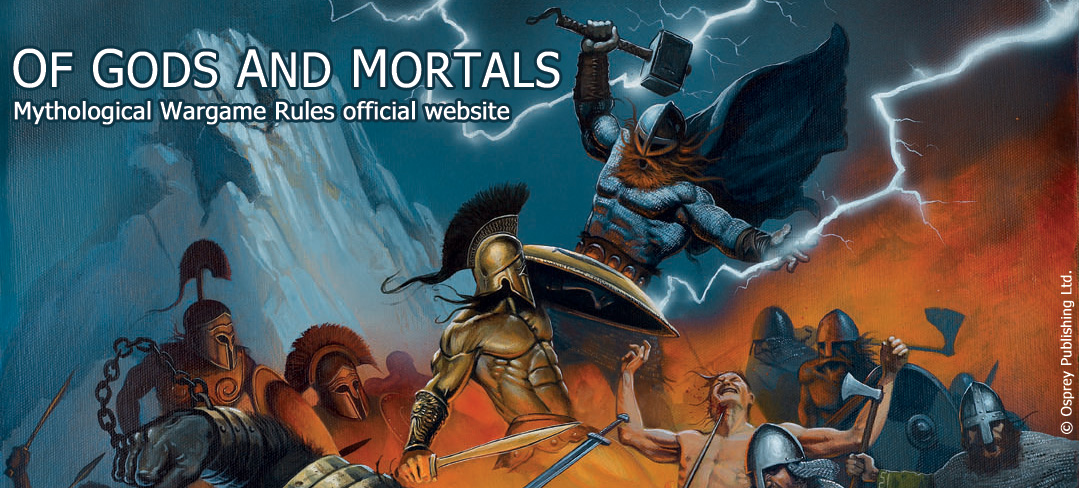Tournament Formula
Each table used in the tournament should be a square of at least 80×80 cm and feature a different scenario. Scenarios should encourage diversity in army design and play on a force’s strengths and weaknesses. For example, one scenario might favour shooting armies, another may prevent a favourite power from being used, or limit a specific activity such as Invocation, and so on. Arranging the tables for the scenario is a responsibility of the tournament organizer. Players should bring their own terrain pieces, markers, etc. Each table should have, at a minimum, a copy of the rulebook, a set of measuring sticks and 6 dice (3 of a different colour to be used as invocation dice).
All players should use models of the same scale. The official OGAM scale is 28mm heroic, but the organizer of the tournament may decide to play in another scale.
All players should bring two printouts of their army roster and give a copy to the tournament umpire or organizer. Opponents should be allowed to read the roster at their request.
If a force includes any Unique model, a player should bring substitute models of the same or inferior point value in case that figure is played by the opponent, as explained in the rulebook. This means that all players should bring at least two gods, since all gods are unique.
Players should be paired so that people from the same club would not fight the first game against each other if possible. If all participants come from different clubs or do not belong to clubs, just pair them randomly.
The tournament is composed of three games of 45 minutes each. The umpire must call for “last five minutes” when the game is about to end. At the moment of call, the acting player should be allowed to finish his/her turn even if this brings the game beyond the 45 minutes limit. Players are encouraged to perform their moves in a timely fashion.
Tables for the second and third game should be assigned so that players fight as many different scenarios as possible.
The players should not know the specific scenario rules until they sit at the table. The organizer is advised to write the rules on a sheet and keep it face down on the table until the game begins, and use the scenario complications outlined below.
Point score: each player scores 3 points for a victory, 1 point for a draw, and 0 point for a loss. At the end of a series of 3 games, the player with the highest total wins the tournament.
Tiebreakers: for each game and for each player, keep track of the total point cost of models destroyed, minus the total of the player’s own models destroyed by the opponent. This total is used as a tie-breaker. If players are still tied, the player who destroyed the largest number of gods and legends (as individual models, not point value) wins. If players are still tied after this count, both players win the tournament.
Tournament Limitations
Each army will be built on 900 points, with a leeway of +/-20 points. Each force MUST include:
1) A single god built on up to 400 points with any number of options;
2) At least one Legend.
Gods built on more than 400 points are permissible; however, they may not take any option.
Players may use profiles from the official army lists in the book, those published on the Osprey blog or on www.ganeshagames.net; no player-designed forces or profiles should be allowed.
If you are interested in creating your own profiles, submit them for approval and they will be published on www.ganeshagames.net and made available for official tournament use.
As further playtest may reveal that certain forces or combinations are too powerful or create grey area situations in the game, certain profiles may be limited or restricted. Keep watching this website for further updates.
Prophecy and Invocation: in tournament games, die results from the Prophecy trait may NOT be used to replace Invocation dice, including dice rolled to bring back into play a slain god.
Morale
In tournament games, no army will test for morale on turn 1 and 2. If a condition exists for such a test in turns 1 or 2, the test is deemed to be automatically successful.
Scenario Complications
Each scenario in a tournament should use Ogam complication cards. We suggest to put them in card sleeve protectors. Randomly draw one per table AFTER set-up and deployment. If a card is drawn which cannot be applied to the scenario (for example, a card that calls for an effect on Mounted models where there are none), draw another card. Each scenario should have a complication. A complication that does not affect at least one of the players is not a complication, and a new one should be selected in that case.
